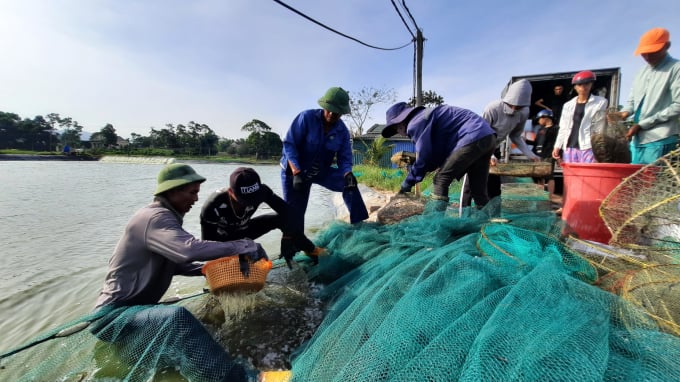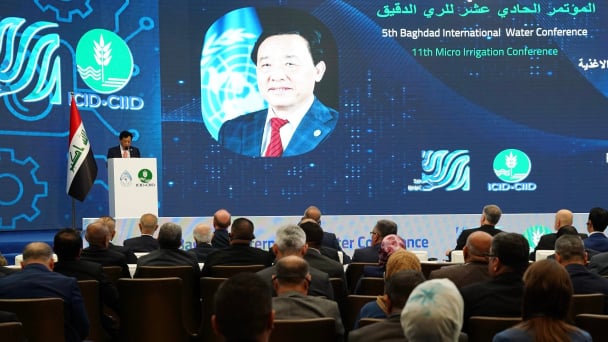June 1, 2025 | 11:55 GMT +7
June 1, 2025 | 11:55 GMT +7
Hotline: 0913.378.918
June 1, 2025 | 11:55 GMT +7
Hotline: 0913.378.918
With over 6,100 square meters of surface water and thousands of big and small islands along with ecosystem diversity, Quang Ninh owned all necessary advantages for developing aquaculture in sustainable way in the connection with marine environment protection.
In 2021, the province's total catch was 149,890 tons, up 3.57% compared to the prior year, reaching 102.66% of the plan. The total production of cultivated seafood was 74,611 tons, reaching 96.9% of the plan. The area of aquaculture farming in Quang Ninh was 21,300 hectares in 2021, an increase of 0.84% over one year ago, reaching 100% of the plan. The aquaculture sector of the province brought a revenue of more than 13 trillion and created jobs for 55,000 workers.

Quang Ninh's total production of catch was 149.890 tons in 2021. Photo: Nguyen Thanh.
Quang Ninh province is on target with increasing farm-raised seafood and decreasing caught fish in which it is focusing on deep-sea fishing, commercial shrimp farming as well as intensive and high-tech aquaculture. Along with that, the Department of Agriculture and Rural Development of Quang Ninh province has instructed the localities and units to adjust the aquaculture structure, expand hi-tech shrimp and fish farms in a sustainable and environmentally-friendly way, focusing on shrimp ad molluscs.
In 2019, after two years of construction, Viet-Uc Seafood Corporation produced the first batch of shrimp seed in Tan Binh commune (Dam Ha district). As a result, the problem of not having enough of shrimp seed could be solved. In 2020 alone, 24 shrimp seed farms operated by Viet -Uc Corporation could produce nearly 1 billion seed shrimps of which 70% were supplied to the shrimp farms in the province. It was a premise to leverage the position of the shrimp in Quang Ninh's aquaculture structure.
The province's policies for attracting focused and orientated investments in the fisheries sector have been effective, creating momentum for the development of large-scale enterprises in the province. With a rapid growth, Quang Ninh's aquaculture sector has seen great opportunities for making breakthroughs in the near future.
It's estimated that by 2025, the total export value of seafood exports will grow by 1.5 times compared to 2020, making up 55-60% of the total value of Quang Ninh's agriculture sector. At the same time, Quang Ninh will continue to improve its capacity of seafood processing to serve exports and domestic consumption.
In addition to the achieved results, Quang Ninh's fisheries sector has faced a great number of challenges including environmental pollution, climate change, rising sea level which have directly impacted aquaculture and fishing. The conflict in space between aquaculture and the urbanization, tourism and industrial development could narrow the area of aquaculture in the province.

Quang Ninh's aquaculture production was 74,611 tons including 16,900 tons of shrimp. Photo: Nguyen Thanh.
On the other hand, aquaculture farming beyond planning has remained happening. In addition, most of the aquaculture farms here were small-scale and lack of connections. Besides, over the past time, the fisheries and aquaculture has been hard hit by Covid19 as aquaculture production and supply chain was disrupted.
To overcome the challenges, Quang Ninh's fisheries strategy has changed strongly in terms of processing, farming to fishing towards modern and sustainable fisheries to meet demand both global and domestic.
Do Dinh Minh, Director of the Sub-Department of Fisheries of Quang Ninh province said the agency would continue to advise the provincial competent agencies to facilitate aquaculture as well as attract investments in aquaculture seed production to have guaranteed and high-quality seed supplies for local fish farmers.
Additionally, Quang Ninh is tightening the management and planning for farming fish in the sea, encouraging fish farmers to use environmentally-friendly materials, developing commercial fish farms as well as improving the quality of seafood, targeting processing and export markets.
Along with that, Quang Ninh is promoting the protection of marine environment through community-involved activities.
In three recent years, Quang Ninh released more than 11 seed shrimps, crabs and fish to their natural habitats; thereby contributing to the conversation of endangered species.
Translated by Mai Tham

(VAN) Seafood by-products are opening a new path, combining green growth and technological innovation to enhance the industry's value.

(VAN) Mr. Nguyen Thanh Cong, Vice Chairman of the Son La Provincial People's Committee, reflects on Son La’s journey from barren hills to fruitful orchards after a decade of hard work.

(VAN) FAO’s Director-General addresses the 5th Baghdad International Water Conference.
/2025/05/26/1716-4-nongnghiep-191706.jpg)
(VAN) Chain linkages, technological innovation, and raw material zoning are three strategic pillars for the coconut industry to strongly develop and elevate its position on the global agricultural map.
![Advanced mariculture – an inevitable trend: [4] Accompanied by scientists](https://t.ex-cdn.com/nongnghiepmoitruong.vn/608w/files/sohk/2025/05/13/1941-pgsts-vo-van-nha-140958_717.jpg)
(VAN) According to Assoc. Prof. Dr. Vo Van Nha, Director of the RIA III, the development of advanced offshore mariculture is no longer an option but an essential path for Vietnam’s fisheries sector.

(VAN) Vietnam is intensifying the development of mollusk farming areas that meet international standards, aiming for sustainable growth and enhancing its export position in the global seafood market.
![Advanced mariculture – an inevitable trend: [3] Policy-driven momentum](https://t.ex-cdn.com/nongnghiepmoitruong.vn/608w/files/doanhtq/2025/05/21/0104-0616-0348-nuoi-bien-170339_789.jpg)
(VAN) To ensure the success of offshore mariculture that uses advanced technologies, it is essential to establish supportive policies that inspire both individuals and enterprises to invest with confidence.